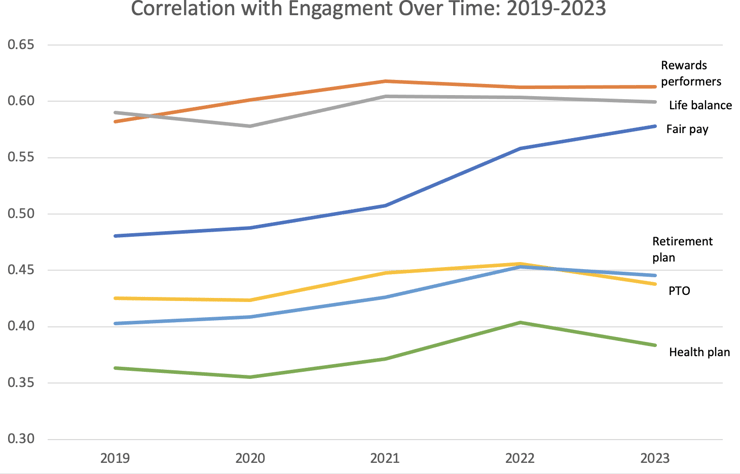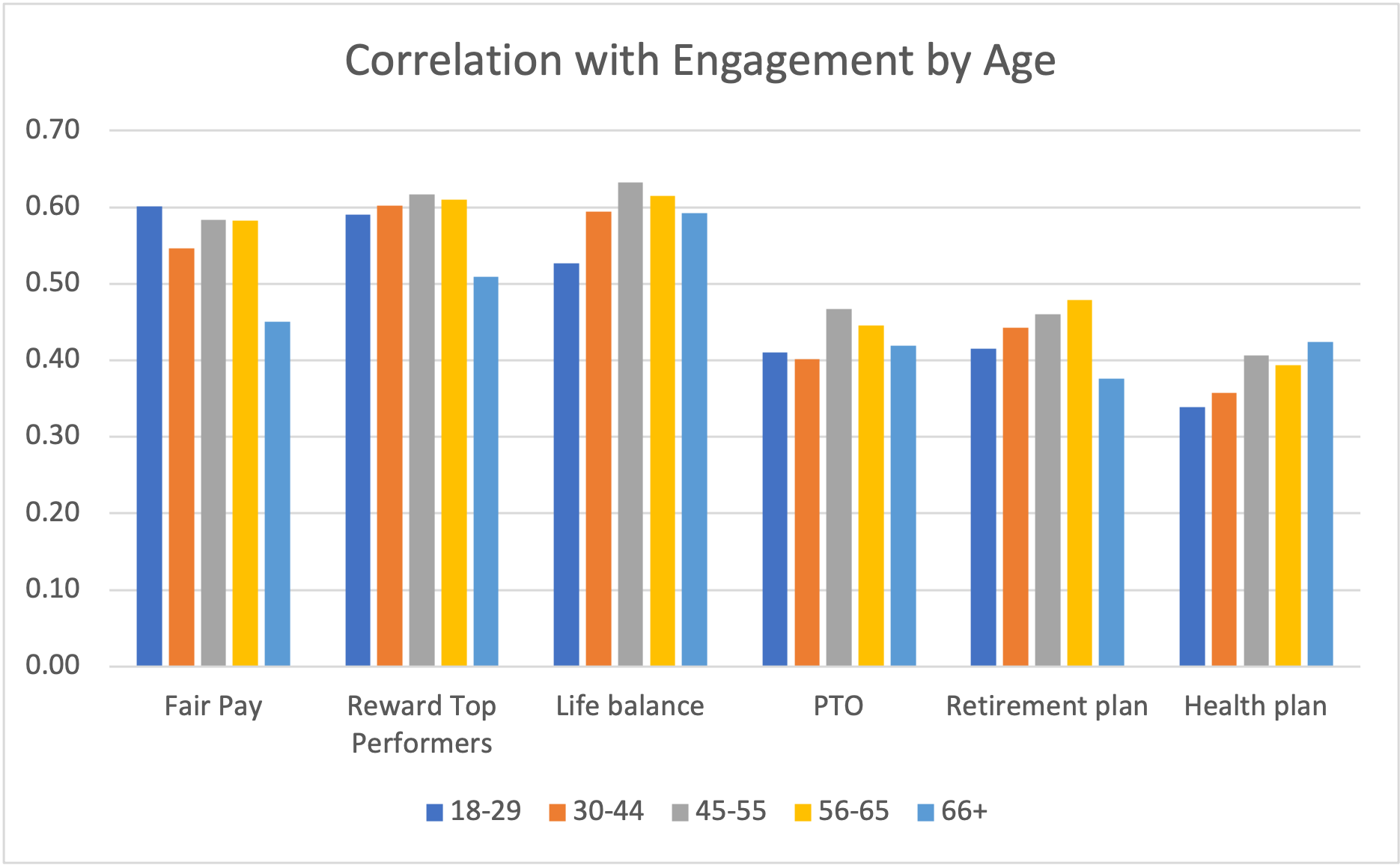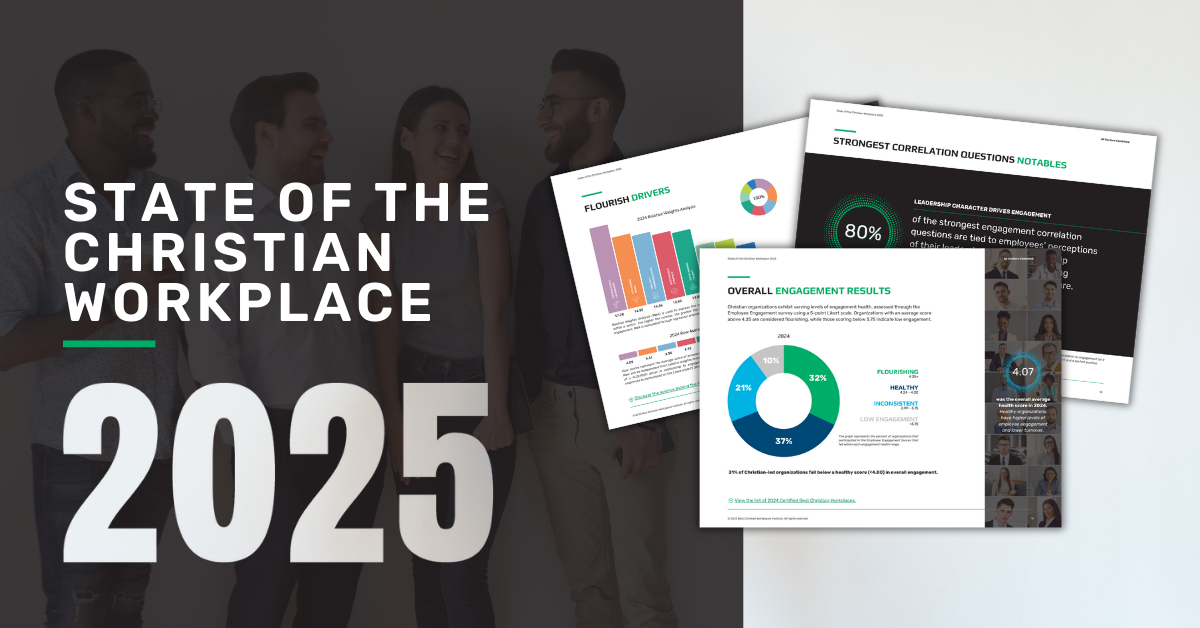State of the Christian Workplace 2024 Report Highlights Employee Engagement Trends
(Mercer Island, WA)—The State of the Christian Workplace 2024 report provides insights into employee engagement and workplace health in Christian-led...
5 min read
 Best Christian Workplaces
:
December, 04 2023
Best Christian Workplaces
:
December, 04 2023

What motivates your employees to bring their full energy to work and engage in the mission of your organization? Is it pay, benefits, or work/life balance?
If you scan the headlines about today’s workers, it’s easy to find anecdotal stories about this topic. You may have read that younger workers don’t want work to consume their lives. Other headlines tell us that the pandemic reinforced the importance of work/life balance for employees. As the cost of rent, mortgages, gas, and food have increased in recent years, maybe pay is a primary motivator for employee engagement.
Stories about individual situations are interesting, but what does the data say?
Best Christian Workplaces has been using a rigorously tested Employee Engagement Survey for years. We provide data-driven information to understand key impacts on employee engagement and workplace health. The factors that lead to a flourishing workplace go beyond pay, benefits, and life balance. For this analysis, we will focus on six aspects of compensation and life balance to guide leaders in prioritizing decisions in this area.
Correlation analysis uncovers the impact of various factors on employee engagement. Correlation ranges from 0 to 1. The higher the correlation for a particular factor, the more impact it has on employee engagement. Think of the factors as levers that push engagement. A higher correlation means that a particular factor is a stronger lever. In simple terms, correlation of less than 0.50 is a weaker lever. Those over 0.50 are stronger levers.
Based on Best Christian Workplaces survey data, fair pay, rewarding top performers, and life balance are stronger levers of employee engagement. Retirement plan, PTO (paid time off), and health plan are weaker levers. The importance of each of these factors varies by demographics.

In looking at the last five years, pay has been an increasingly important lever for employee engagement. The correlation coefficient moved from 0.48 in 2019 to 0.58 in 2023. This factor moved up more than any of the other factors in this analysis.
Considering the data on inflation, it makes sense that pay is important to employees. People are losing ground in terms of purchasing power. They are paying more for gas, groceries, rent, mortgages, and cars.
However, the factors of “rewards top performers” and “life balance” remain higher than pay for each of the five years. Pay is increasingly important to employees, but the perception that their organization rewards performance, and helps maintain life balance remains more important than pay in 2023.
Of the factors with a correlation coefficient below 0.50, the importance of a retirement plan has increased to edge out PTO. Flexible work situations that help work-life balance are more important than PTO. This doesn't mean that employees don't need PTO, health, and retirement plans. However, an emphasis on these factors won't drive engagement as much as focusing on pay, life balance, and career paths.

.png?width=511&height=599&name=work%20life%20balance%20_Paid%20Fairly_table%20(500%20x%20586%20px).png)
The youngest cohort of workers had the strongest increase in pay as a key factor in employee engagement. The correlation coefficient for pay in the 18–29-year-old group went from 0.48 in 2019 to 0.60 in 2023. Younger workers felt that life balance was less important than any other age group in 2023 (at 0.53). Workers at the beginning of their careers are interested in being paid fairly and pay is an important lever in employee engagement. Life balance may be a benefit that younger workers can’t yet afford to enjoy, as they pay off student loans, and face high rents in many parts of the country.
The importance of pay also increased strongly for those in the 30-44 and 45-55 age groups. The movement on pay was smaller for the 56 and over groups.
In the 30-44 age group, rewarding top performers was the strongest lever in this group of questions. This is true for 2023 (0.60) and in the five-year average (0.59). This is followed closely by life balance (0.59 in 2023 and 0.58 over 5 years). While pay is still important (0.55 in 2023), this age group is building their career and engaged in family formation. They are looking for an organization that can offer them a career path based on their performance, and balance to pursue other life goals.
Life balance was the most important factor in 2023 for those in the 45-55 age group (0.63), above all the other age groups. They also cared that their organization rewards top performers (0.62 in 2023), which makes sense for these people who are in key years for career advancement. These workers are also interested in compensation, as the correlation coefficient for pay went up 0.11 points over the five years (to 0.58 in 2023). And while PTO and retirement plans were still below 0.50 for this group, they are increasingly important. In 2023, retirement plans had a correlation coefficient of 0.48 and PTO was at 0.45. The data for workers in this age cohort reflects their life stage. They may face the pressures of family responsibilities—both for children and aging parents. And they are in their prime earning years, to save for retirement and higher education for their children.
Employees in the 56–65 age group have equal emphasis on life balance and rewards top performers in 2023 (0.61). In the five-year average, life balance is the top lever (0.62). While pay increased in importance over the five-year period, it didn’t increase as much as it did for those in younger groups (0.50 in 2019, 0.58 in 2023). In terms of the importance of other benefits, retirement plan was higher for this age group than any of the others in 2023 (0.48) which is consistent with their position near the end of their working years.
For the oldest cohort of workers, those 66 and above, life balance is the key lever among the compensation factors. Looking at the average over the past 5 years, life balance is well above the other factors at 0.62. Rewards top performers is 0.56 and pay is 0.48. PTO is higher in this group than any other age sector, at 0.50.
Pay and benefits factors peaked for this age group in 2022. The stock market was worrisome for those nearing retirement in 2022 but became less of an issue in 2023. While this group may be less sensitive to housing inflation, they do experience inflation related to groceries and gas.
Older workers are engaged and motivated by meaningful work that also allows them to have balance in their lives.
How do leaders interpret and act on data related to age demographics? Employees will respond differently to incentives related to pay, life balance, and other compensation factors based on their age group. This doesn’t mean that you offer different packages based on age. But awareness of how to attract and retain top talent includes an understanding of the different priorities and pressures that employees face. All age groups display a correlation of over 0.50 for pay, life balance, and rewards top performers, with the exception of the 66+ group.
Understanding the motivations of different groups of employees is important in considering compensation and work policies. In addition, wise leaders will consider how their own preferences color their perceptions of other groups. For example, if senior leaders for an organization are in the 56-65 or 66+ age group, they may not understand the importance of pay for those in the younger age groups. Your own experience is not the experience of everyone else in the workforce. Consider the people you lead and what their compensation needs might be, based on objective data.
If you base your compensation strategy on data, you will consider that life balance is a strong lever for employee engagement in 2023, along with fair pay and rewarding top performers. Life balance has been a steady factor in engagement over time, while the importance of pay has fluctuated based on economic conditions.
This data is based on thousands of surveys conducted by Best Christian Workplaces to empower organizations to flourish based on understanding and acting on their own employee engagement results. Along with learning about overall trends based on this data, you can learn more about your own staff and their perceptions of the state of your workplace. Conduct an Employee Engagement Survey with Best Christian Workplaces and learn about the health of your organization and your primary levers of engagement.
(Mercer Island, WA)—The State of the Christian Workplace 2024 report provides insights into employee engagement and workplace health in Christian-led...

(Mercer Island, WA)—The State of the Christian Workplace 2025 report provides insights into employee engagement and workplace health in Christian-led...

Before coming to Best Christian Workplaces, I worked with missionaries around the world training them as leaders to spread the Gospel. When talking...